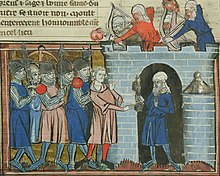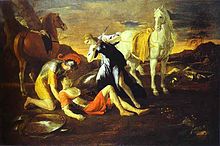Tancred, Prince of Galilee
| Tancred | |
|---|---|
 19th-century depiction of Tancred by Merry-Joseph Blondel. | |
| Prince of Galilee | |
| First rule | 1099–1101 |
| Successor | Hugh of Fauquembergues |
| Second rule | 1109–1112 |
| Predecessor | Gervase of Bazoches |
| Successor | Joscelin I of Courtenay |
| Born | c. 1075 Italy |
| Died | 5 December 1112 Principality of Antioch (now Antakya, Hatay, Turkey) |
| Burial | |
| Spouse | Cecile of France |
| House | House of Hauteville |
| Father | Odo the Good Marquis |
| Mother | Emma of Hauteville |
| Religion | Roman Catholic |
Tancred (c. 1075 – December 5 or December 12, 1112) was an Italo-Norman leader of the First Crusade who later became Prince of Galilee and regent of the Principality of Antioch.[1][2] Tancred came from the house of Hauteville and was the great-grandson of Norman lord Tancred of Hauteville.
Biography
[edit]Early life
[edit]Tancred was a son of Emma of Hauteville and Odo the Good Marquis. His maternal grandparents were Robert Guiscard and Guiscard's first wife Alberada of Buonalbergo. Emma was also a sister of Bohemond I of Antioch.
First Crusade
[edit]In 1096, Tancred joined his maternal uncle Bohemond on the First Crusade, and the two made their way to Constantinople. There, he was pressured to swear an oath to Byzantine Emperor Alexius I Comnenus, promising to give back any conquered land to the Byzantine Empire. Although the other leaders did not intend to keep their oaths, Tancred refused to swear the oath altogether. He participated in the siege of Nicaea in 1097, but the city was taken by Alexius' army after secret negotiations with the Seljuk Turks. Because of this, Tancred was very distrustful of the Byzantines.

In 1097, the Crusaders divided their forces at Heraclea Cybistra and Tancred entered the Levant by passing south through the Cilician Gates.[3] He displayed the skills of a brilliant strategist by seizing five of the most important sites in Cilicia Pedias, which included the ancient cities of Tarsus and Adana, the great emporium at Mopsuestia, and the strategic castles at Sarvandikar and Anazarbus.[4] The last three settlements were annexed to the Principality of Antioch. During their fourteen-year occupation of Anazarbus the Crusaders built the magnificent donjon atop the center of the fortified outcrop. At Sarvandikar, which controlled the strategic Amanus Pass, Tancred imprisoned Raymond of Saint-Gilles in 1101/02.[5]
He assisted in the siege of Antioch in 1098. One year later, during the assault on Jerusalem, Tancred, along with Gaston IV of Béarn, claimed to have been the first Crusader to enter the city on July 15. (Alternative claim[Note 1]) When the city fell, Tancred along with other crusading armies participated in the sacking of the city. his biographer Ralph of Caen is cited to have said that "Tancred was one of the most active participants in the decimation of the conquered Saracens.”[9] During the final stages of the battle Tancred gave his banner to a group of the citizens who had fled to the roof of the Temple of Solomon.[9] This should have assured their safety, but they were massacred, along with many others, during the sack of the city.[9] The author of the Gesta Francorum (Deeds of the Franks) records that, when Tancred realized this, he was "greatly angered". However, his fury was calmed by the argument that the possibility of a counter-attack meant it was too dangerous for the citizens of Jerusalem to be left alive.[9] When the Kingdom of Jerusalem was established, Tancred became Prince of Galilee.
Regent of Antioch
[edit]In 1100, Tancred became regent of Antioch when Bohemond was taken prisoner by the Danishmends at the Battle of Melitene. He expanded the territory of the Latin principality by capturing land from the Byzantines, although, over the next decade, Alexius attempted, unsuccessfully, to bring him under Byzantine control. In 1104, he also took control of the County of Edessa when Baldwin II was taken captive after the Battle of Harran. After Baldwin's release in late 1108, he had to fight Tancred (probably early 1109) to regain control of the county; Tancred was eventually defeated and returned to Antioch. After Harran, Bohemond returned to Europe to recruit more Crusaders, again leaving his nephew as regent in Antioch. Tancred's victory over Radwan of Aleppo at the Battle of Artah in 1105 allowed the Latin principality to recover some its territories east of the Orontes River.[10]

In 1108, Tancred refused to honour the Treaty of Devol, in which Bohemond swore an oath of fealty to Alexius, and for decades afterwards Antioch remained independent of the Byzantine Empire. In late September 1108, near Turbessel, Tancred, with 1,500 Frankish knights and infantry, and 600 Turkish horsemen sent by Fakhr al-Mulk Ridwan confronted Baldwin II and the 2,000 men of Jawali Saqawa, atabeg of Mosul. Tancred and Ridwan routed Jawali's men, who took refuge in Turbessel. Later on, Tancred who had initially refused to abandon Turbessel to Baldwin II, decided at the assembly in Château Pèlerin in April 1109, to give up Turbessel in return for his restoration to his old domains in the Kingdom of Jerusalem.[11]
In 1110, he brought Krak des Chevaliers under his control, which would later become an important castle in the County of Tripoli. Tancred remained the regent of Antioch for Bohemond II until his death in 1112 during a typhoid epidemic. He had married Cecile of France, but died childless. Tancred was buried in the porch of St. Peter, the cathedral of Antioch.[12]
The Gesta Tancredi is a biography of Tancred written in Latin by Ralph of Caen, a Norman who joined the First Crusade and served under Tancred and Bohemond. An English translation was co-published in 2005 by Bernard S. Bachrach and David S. Bachrach.
Character
[edit]Ralph of Caen details Tancred's personality in his chronicle and biography of him in the Gesta Tancredi. Ralph notes how Tancred was well aware of the innate sinfulness of the knightly profession and the violence it entailed, and how this led him to give up his life in Norman-dominated southern Italy to take part in Pope Urban II’s call for an armed pilgrimage.[13] Tancred is described by Ralph as a very pious, violent hawk of a man. He was a shrewd, opportunistic warrior bred for conquest with a combative nature, but it also showcases a very pragmatic side of him concerning the even distribution among his men of the plunder gained following the despoliation of the mosques of Jerusalem after the city's conquest by the Crusaders in 1099.[14]
In fiction
[edit]
Tancred appears as a character in Torquato Tasso's 16th-century poem Jerusalem Delivered, in which he is portrayed as an epic hero and given a fictional love interest, the pagan warrior-maiden Clorinda. This poem was the inspiration of the film, The Mighty Crusaders, about the Siege of Jerusalem in June-July of 1099. He is also loved by the Princess Erminia of Antioch. Portions of Tasso's verses were set by Claudio Monteverdi in his 1624 dramatic work Il Combattimento di Tancredi e Clorinda. He also appears in one of the scenes in Imre Madách's The Tragedy of Man. In Tom Harper's Siege of Heaven he is depicted as a violent psychopath. His portrayal is similar although slightly more humorous in Alfred Duggan's novel Count Bohemond.
Tancred also appears as one of the Crusade leaders in Sir Walter Scott's novel Count Robert of Paris who returned to Constantinople from Scutari to ensure a fair contest between Count Robert and his challenger. The novel Tancred, or the New Crusade by Benjamin Disraeli centres around the adventures of an imagined modern descendant and namesake of the Prince of Galilee. Rossini's opera Tancredi is based on Tasso, via Voltaire's play Tancrède of 1759.
Notes
[edit]- ^ Alternatively, it is claimed that the first crusader to enter Jerusalem was Ludolf of Tournai,[6][7][8] and he was followed by his brother Englebert.[citation needed]
References
[edit]- ^ Ernest Barker (1911). "Tancred (crusader)". In Chisholm, Hugh (ed.). Encyclopædia Britannica. 26. (11th ed.). Cambridge University Press. pp. 394-395.
- ^ Grabois, Aryeh (2006). In The Crusades - An Encyclopedia. pp. 1143-1145.
- ^ Ralph of Caen (2005). The Gesta Tancredi of Ralph of Caen: A History of the Normans on the First Crusade. Crusade Texts in Translation. Translated by Bernard Bachrach; David Bachrach. Ashgate Publishing. pp. 57–58. ISBN 978-0-7546-3710-3. OL 3420938M. Wikidata Q112759923.
- ^ Edwards, Robert W. (1987). The Fortifications of Armenian Cilicia: Dumbarton Oaks Studies XXIII. Washington, D.C.: Dumbarton Oaks, Trustees for Harvard University. pp. 67, 69–70, 199–200, 216. ISBN 0-88402-163-7.
- ^ Matthew of Edessa, Recueil des historiens des croisades, Documents arméniens, vol. 1, reprint: Farnborough, 1967, p. 57.
- ^ Reichberg, Gregory M.; Syse, Henrik; Begby, Endre (2006). The ethics of war: classic and contemporary readings. Wiley-Blackwell. p. 102. ISBN 978-1-4051-2377-8.
- ^ J. S. C. Riley-Smith, Jonathan Phillips, Alan V. Murray, Guy Perry and Nicholas Morton (2016). A Database of Crusaders to the Holy Land, 1095–1149. "Lethold of Tournai".
{{cite web}}: CS1 maint: multiple names: authors list (link) CS1 maint: numeric names: authors list (link) - ^ Asbridge, Thomas (2004). "The First Crusade, A New History," Oxford University Press. p. 315.
- ^ a b c d Nicholson, Robert Lawrance (1940). Tancred: A Study of His Career and Work in Their Relation to the First Crusade and the Establishment of the Latin States in Syria and Palestine. The University of Chicago. pp. 7, 94–95.
- ^ Smail, p. 28
- ^ Lock 2006, p. 30.
- ^ Runciman 1987, pp. 126–126.
- ^ Gesta Tancredi. pp. 21–22.
- ^ Gesta Tancredi. pp. 143–145.
Sources
[edit]- Edwards, Robert W., The Fortifications of Armenian Cilicia: Dumbarton Oaks Studies XXIII, Washington, D.C.: Dumbarton Oaks, Trustees for Harvard University (1987). ISBN 0-88402-163-7
- Lock, Peter (2006). The Routledge Companion to the Crusades. Routledge. ISBN 9-78-0-415-39312-6.
- Robert Lawrence Nicholson, Tancred: A Study of His Career and Work. AMS Press, 1978.
- Peters, Edward, ed., The First Crusade: The Chronicle of Fulcher of Chartres and Other Source Materials, (Philadelphia: University of Pennsylvania Press, 1998)
- Runciman, Steven (3 December 1987). A History of the Crusades. CUP Archive. pp. 125–126. ISBN 978-0-521-34771-6. Retrieved 20 February 2024.
- Smail, R. C. Crusading Warfare 1097–1193. New York: Barnes & Noble Books, (1956) 1995. ISBN 1-56619-769-4
- Ferdinandi, Sergio (2017). La Contea Franca di Edessa. Fondazione e Profilo Storico del Primo Principato Crociato nel Levante (1098-1150). Pontificia Università Antonianum - Rome. ISBN 978-88-7257-103-3.
External links
[edit]- (in English) Gesta Tancredi
 Texts on Wikisource:
Texts on Wikisource:
- "Tancred". Collier's New Encyclopedia. 1921.
- "Tancred". Encyclopedia Americana. 1920.
- "Tancred". The New Student's Reference Work. 1914.
- "Tancred (d. 1112)". Encyclopædia Britannica (11th ed.). 1911.
- "Tancred". The American Cyclopædia. 1879.

